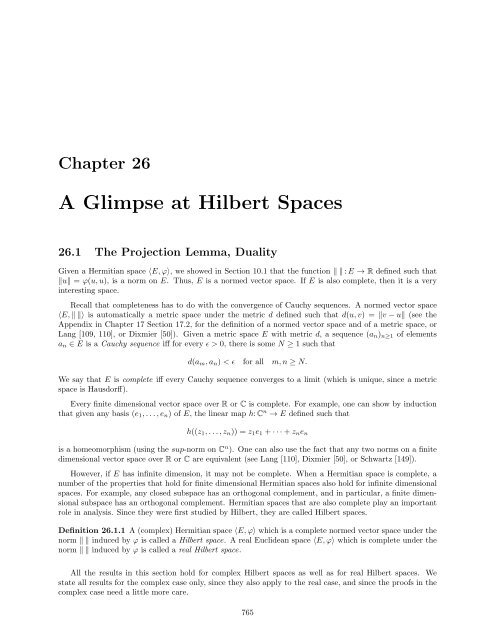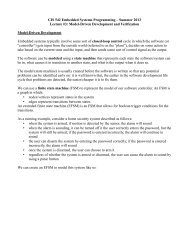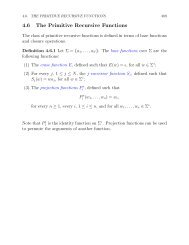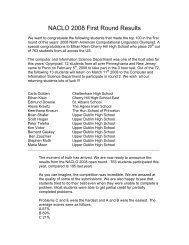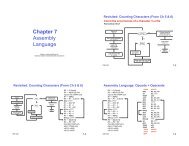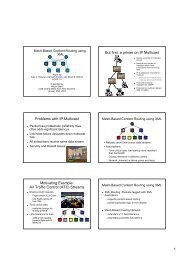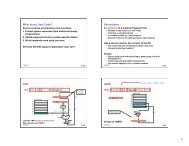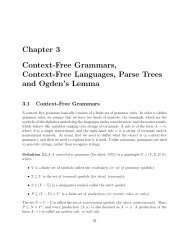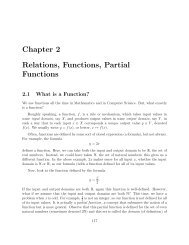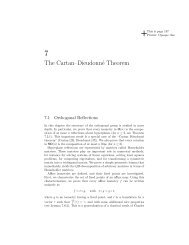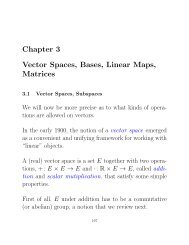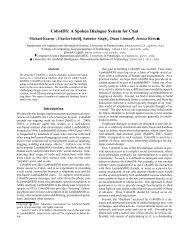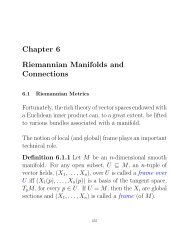A Glimpse at Hilbert Spaces
A Glimpse at Hilbert Spaces
A Glimpse at Hilbert Spaces
Create successful ePaper yourself
Turn your PDF publications into a flip-book with our unique Google optimized e-Paper software.
Chapter 26<br />
A<strong>Glimpse</strong><strong>at</strong><strong>Hilbert</strong><strong>Spaces</strong><br />
26.1 The Projection Lemma, Duality<br />
Given a Hermitian space 〈E,ϕ〉, we showed in Section 10.1 th<strong>at</strong> the function : E → R defined such th<strong>at</strong><br />
u = ϕ(u, u), is a norm on E. Thus, E is a normed vector space. If E is also complete, then it is a very<br />
interesting space.<br />
Recall th<strong>at</strong> completeness has to do with the convergence of Cauchy sequences. Anormedvectorspace<br />
〈E,〉 is autom<strong>at</strong>ically a metric space under the metric d defined such th<strong>at</strong> d(u, v) =v − u (see the<br />
Appendix in Chapter 17 Section 17.2, for the definition of a normed vector space and of a metric space, or<br />
Lang [109, 110], or Dixmier [50]). Given a metric space E with metric d, asequence(an)n≥1 of elements<br />
an ∈ E is a Cauchy sequence iff for every ɛ>0, there is some N ≥ 1suchth<strong>at</strong><br />
d(am,an)
766 CHAPTER 26. A GLIMPSE AT HILBERT SPACES<br />
Example 1. The space l 2 of all countably infinite sequences x =(xi)i∈N of complex numbers such th<strong>at</strong><br />
∞<br />
i=0 |xi| 2 < ∞ is a <strong>Hilbert</strong> space. It will be shown l<strong>at</strong>er th<strong>at</strong> the map ϕ: l 2 × l 2 → C defined such th<strong>at</strong><br />
ϕ ((xi)i∈N, (yi)i∈N) =<br />
is well defined, and th<strong>at</strong> l 2 is a <strong>Hilbert</strong> space under ϕ. In fact, we will prove a more general result (Lemma<br />
26.3.2).<br />
Example 2. The set C∞ [a, b] of smooth functions f:[a, b] → C is a Hermitian space under the Hermitian<br />
form<br />
〈f,g〉 =<br />
b<br />
a<br />
∞<br />
i=0<br />
f(x)g(x)dx,<br />
but it is not a <strong>Hilbert</strong> space because it is not complete. It is possible to construct its completion L 2 ([a, b]),<br />
which turns out to be the space of Lebesgue integrable functions on [a, b].<br />
Remark: Given a Hermitian space E (with Hermitian product 〈−, −〉), it is possible to construct a <strong>Hilbert</strong><br />
space Eh (with Hermitian product 〈−, −〉h) and a linear map j: E → Eh, suchth<strong>at</strong><br />
〈u, v〉 = 〈j(u),j(v)〉h<br />
for all u, v ∈ E, andj(E) is dense in Eh. Furthermore, Eh is unique up to isomorphism. For details, see<br />
Bourbaki [21].<br />
One of the most important facts about finite-dimensional Hermitian (and Euclidean) spaces is th<strong>at</strong> they<br />
have orthonormal bases. This implies th<strong>at</strong>, up to isomorphism, every finite-dimensional Hermitian space is<br />
isomorphic to C n (for some n ∈ N) and th<strong>at</strong> the inner product is given by<br />
〈(x1,...,xn), (y1,...,yn)〉 =<br />
xiyi<br />
n<br />
xiyi.<br />
Furthermore, every subspace W has an orthogonal complement W ⊥ , and the inner product induces a n<strong>at</strong>ural<br />
duality between E and E ∗ ,whereE ∗ is the space of linear forms on E.<br />
When E is a <strong>Hilbert</strong> space, E may be infinite dimensional, often of uncountable dimension. Thus, we<br />
can’t expect th<strong>at</strong> E always have an orthonormal basis. However, if we modify the notion of basis so th<strong>at</strong> a<br />
“<strong>Hilbert</strong> basis” is an orthogonal family th<strong>at</strong> is also dense in E, i.e., every v ∈ E is the limit of a sequence<br />
of finite combin<strong>at</strong>ions of vectors from the <strong>Hilbert</strong> basis, then we can recover most of the “nice” properties<br />
of finite-dimensional Hermitian spaces. For instance, if (uk)k∈K is a <strong>Hilbert</strong> basis, for every v ∈ E, wecan<br />
define the Fourier coefficients ck = 〈v, uk〉/uk, andthen,vis the “sum” of its Fourier series <br />
k∈K ckuk.<br />
However, the cardinality of the index set K can be very large, and it is necessary to define wh<strong>at</strong> it means<br />
for a family of vectors indexed by K to be summable. We will do this in Section 26.2. It turns out th<strong>at</strong><br />
every <strong>Hilbert</strong> space is isomorphic to a space of the form l2 (K), where l2 (K) is a generaliz<strong>at</strong>ion of the space<br />
of Example 1 (see Theorem 26.3.7, usually called the Riesz-Fischer theorem).<br />
Our first goal is to prove th<strong>at</strong> a closed subspace of a <strong>Hilbert</strong> space has an orthogonal complement. We<br />
also show th<strong>at</strong> duality holds if we redefine the dual E ′ of E to be the space of continuous linear maps on<br />
E. Our present<strong>at</strong>ion closely follows Bourbaki [21]. We also were inspired by Rudin [145], Lang [109, 110],<br />
Schwartz [149, 148], and Dixmier [50]. In fact, we highly recommend Dixmier [50] as a clear and simple text<br />
on the basics of topology and analysis. We first prove the so-called projection lemma.<br />
Recall th<strong>at</strong> in a metric space E, asubsetX of E is closed iff for every convergent sequence (xn) of points<br />
xn ∈ X, the limit x = limn→∞xn also belongs to X. Theclosure X of X is the set of all limits of convergent<br />
i=1
26.1. THE PROJECTION LEMMA, DUALITY 767<br />
sequences (xn) of points xn ∈ X. Obviously, X ⊆ X. We say th<strong>at</strong> the subset X of E is dense in E iff<br />
E = X, the closure of X, which means th<strong>at</strong> every a ∈ E is the limit of some sequence (xn) of points xn ∈ X.<br />
Convex sets will again play a crucial role.<br />
First, we st<strong>at</strong>e the following easy “parallelogram inequality”, whose proof is left as an exercise.<br />
Lemma 26.1.2 If E is a Hermitian space, for any two vectors u, v ∈ E, wehave<br />
From the above, we get the following lemma:<br />
u + v 2 + u − v 2 =2(u 2 + v 2 ).<br />
Lemma 26.1.3 If E is a Hermitian space, given any d, δ ∈ R such th<strong>at</strong> 0 ≤ δ
768 CHAPTER 26. A GLIMPSE AT HILBERT SPACES<br />
Lemma 26.1.4 Let E be a metric space.<br />
(1) For every subset X ⊆ E, δ(X) =δ(X).<br />
(2) If E is a complete metric space, for every sequence (Fn) of closed nonempty subsets of E such th<strong>at</strong><br />
Fn+1 ⊆ Fn, iflimn→∞ δ(Fn) =0,then ∞<br />
n=1 Fn consists of a single point.<br />
We are now ready to prove the crucial projection lemma.<br />
Lemma 26.1.5 (Projection lemma) Let E be a <strong>Hilbert</strong> space.<br />
(1) For any nonempty convex and closed subset X ⊆ E, foranyu∈E, thereisauniquevectorpX(u) ∈ X<br />
such th<strong>at</strong><br />
u − pX(u) = inf u − v = d(u, X).<br />
v∈X<br />
(2) The vector pX(u) is the unique vector w ∈ E s<strong>at</strong>isfying the following property (see Figure 26.2):<br />
w ∈ X and ℜ〈u − w, z − w〉 ≤0 for all z ∈ X. (∗)<br />
u<br />
w<br />
Figure 26.2: Inequality of Lemma 26.1.5<br />
Proof .(1)Letd = infv∈X u − v = d(u, X). We define a sequence Xn of subsets of X as follows: for every<br />
n ≥ 1,<br />
<br />
Xn = v ∈ X | u−v ≤d + 1<br />
<br />
.<br />
n<br />
It is immedi<strong>at</strong>ely verified th<strong>at</strong> each Xn is nonempty (by definition of d), convex, and th<strong>at</strong> Xn+1 ⊆ Xn. Also,<br />
by Lemma 26.1.3, we have<br />
sup{w − v |v, w ∈ Xn} ≤ 12d/n,<br />
and thus, <br />
n≥1 Xn contains <strong>at</strong> most one point. We will prove th<strong>at</strong> <br />
n≥1 Xn contains exactly one point,<br />
namely, pX(u). For this, define a sequence (wn)n≥1 by picking some wn ∈ Xn for every n ≥ 1. We claim<br />
th<strong>at</strong> (wn)n≥1 is a Cauchy sequence. Given any ɛ>0, if we pick N such th<strong>at</strong><br />
z<br />
N> 12d<br />
,<br />
ɛ2 since (Xn)n≥1 is a monotonic decreasing sequence, for all m, n ≥ N, wehave<br />
wm − wn ≤ 12d/N < ɛ,<br />
X
26.1. THE PROJECTION LEMMA, DUALITY 769<br />
as desired. Since E is complete, the sequence (wn)n≥1 has a limit w, and since wn ∈ X and X is closed, we<br />
must have w ∈ X. Also observe th<strong>at</strong><br />
u − w ≤u − wn + wn − w ,<br />
and since w is the limit of (wn)n≥1 and<br />
u − wn ≤d + 1<br />
n ,<br />
given any ɛ>0, there is some n large enough so th<strong>at</strong><br />
and thus<br />
1 ɛ<br />
<<br />
n 2<br />
and wn − w ≤ ɛ<br />
2 ,<br />
u − w ≤d + ɛ.<br />
Since the above holds for every ɛ>0, we have u − w = d. Thus, w ∈ Xn for all n ≥ 1, which proves<br />
th<strong>at</strong> <br />
n≥1 Xn = {w}. Now,anyz∈Xsuch th<strong>at</strong> u − z = d(u, X) =d also belongs to every Xn, andthus<br />
z = w, proving the uniqueness of w, which we denote as pX(u).<br />
(2) Let w ∈ X. Since X is convex, z =(1− λ)pX(u)+λw ∈ X for every λ, 0≤ λ ≤ 1. Then, we have<br />
for all λ, 0≤ λ ≤ 1, and since<br />
for all λ, 0
770 CHAPTER 26. A GLIMPSE AT HILBERT SPACES<br />
for all z ∈ X. If we rest<strong>at</strong>e the condition as<br />
〈u − pX(u),pX(u) − z〉 ≥0<br />
for all z ∈ X, this says th<strong>at</strong> the absolute value of the measure of the angle between the vectors u − pX(u)<br />
and pX(u) − z is <strong>at</strong> most π/2. This makes sense, since X is convex, and points in X must be on the side<br />
opposite to the “tangent space” to X <strong>at</strong> pX(u), which is orthogonal to u − pX(u). Of course, this is only an<br />
intuitive description, since the notion of tangent space has not been defined!<br />
The map pX: E → X is continuous, as shown below.<br />
Lemma 26.1.6 Let E be a <strong>Hilbert</strong> space. For any nonempty convex and closed subset X ⊆ E, themap<br />
pX: E → X is continuous.<br />
Proof .Foranytwovectorsu, v ∈ E, let x = pX(u) − u, y = pX(v) − pX(u), and z = v − pX(v). Clearly,<br />
and from Lemma 26.1.5 (2), we also have<br />
from which we get<br />
v − u = x + y + z,<br />
ℜ〈x, y〉 ≥0 and ℜ〈z,y〉≥0,<br />
v − u 2 = x + y + z 2 = x + z + y 2<br />
= x + z 2 + y 2 +2ℜ〈x, y〉 +2ℜ〈z,y〉<br />
≥y 2 = pX(v) − pX(u) 2 .<br />
However, pX(v) − pX(u) ≤v − u obviously implies th<strong>at</strong> pX is continuous.<br />
We can now prove the following important lemma.<br />
Lemma 26.1.7 Let E be a <strong>Hilbert</strong> space.<br />
(1) For any closed subspace V ⊆ E, wehaveE = V ⊕V ⊥ ,andthemappV : E → V is linear and continuous.<br />
(2) The projection pV (u) is the unique vector w ∈ E such th<strong>at</strong><br />
w ∈ V and 〈u − w, z〉 =0 for all z ∈ V .<br />
Proof . (1) First, we prove th<strong>at</strong> u − pV (u) ∈ V ⊥ for all u ∈ E. For any v ∈ V , since V is a subspace,<br />
z = pV (u)+λv ∈ V for all λ ∈ C, and since V is convex and nonempty (since it is a subspace), and closed<br />
by hypothesis, by Lemma 26.1.5 (2), we have<br />
ℜ(λ 〈u − pV (u),v〉) =ℜ(〈u − pV (u),λv〉 = ℜ〈u − pV (u),z− pV (u)〉 ≤0<br />
for all λ ∈ C. In particular, the above holds for λ = 〈u − pV (u),v〉, which yields<br />
|〈u − pV (u),v〉|≤0,<br />
and thus, 〈u − pV (u),v〉 =0. Asaconsequence,u − pV (u) ∈ V ⊥ for all u ∈ E. Since u = pV (u)+u − pV (u)<br />
for every u ∈ E, wehaveE = V + V ⊥ . On the other hand, since 〈−, −〉 is positive definite, V ∩ V ⊥ = {0},<br />
and thus E = V ⊕ V ⊥ .<br />
We already proved in Lemma 26.1.6 th<strong>at</strong> pV : E → V is continuous. Also, since<br />
pV (λu + µv) − (λpV (u)+µpV (v)) = pV (λu + µv) − (λu + µv)+λ(u − pV (u)) + µ(v − pV (v)),
26.1. THE PROJECTION LEMMA, DUALITY 771<br />
for all u, v ∈ E, and since the left-hand side term belongs to V , and from wh<strong>at</strong> we just showed, the right-hand<br />
side term belongs to V ⊥ ,wehave<br />
showing th<strong>at</strong> pV is linear.<br />
pV (λu + µv) − (λpV (u)+µpV (v)) = 0,<br />
(2) This is basically obvious from (1). We proved in (1) th<strong>at</strong> u − pV (u) ∈ V ⊥ , which is exactly the<br />
condition<br />
〈u − pV (u),z〉 =0<br />
for all z ∈ V . Conversely, if w ∈ V s<strong>at</strong>isfies the condition<br />
〈u − w, z〉 =0<br />
for all z ∈ V , since w ∈ V ,everyvectorz ∈ V is of the form y − w, with y = z + w ∈ V ,andthus,wehave<br />
〈u − w, y − w〉 =0<br />
for all y ∈ V , which implies the condition of Lemma 26.1.5 (2):<br />
ℜ〈u − w, y − w〉 ≤0<br />
for all y ∈ V . By Lemma 26.1.5, w = pV (u) is the projection of u onto V .<br />
Let us illustr<strong>at</strong>e the power of Lemma 26.1.7 on the following “least squares” problem. Given a real<br />
m × n-m<strong>at</strong>rix A and some vector b ∈ R m , we would like to solve the linear system<br />
Ax = b<br />
in the least-squares sense, which means th<strong>at</strong> we would like to find some solution x ∈ R n th<strong>at</strong> minimizes the<br />
Euclidean norm Ax − b of the error Ax − b. It is actually not clear th<strong>at</strong> the problem has a solution, but<br />
it does! The problem can be rest<strong>at</strong>ed as follows: Is there some x ∈ R n such th<strong>at</strong><br />
or equivalently, is there some z ∈ Im (A) suchth<strong>at</strong><br />
Ax − b = inf Ay − b ,<br />
y∈Rn z − b = d(b, Im (A)),<br />
where Im (A) ={Ay ∈ Rm | y ∈ Rn }, the image of the linear map induced by A. Since Im (A) is a closed<br />
subspace of Rm , because we are in finite dimension, Lemma 26.1.7 tells us th<strong>at</strong> there is a unique z ∈ Im (A)<br />
such th<strong>at</strong><br />
z − b = inf Ay − b ,<br />
y∈Rn and thus, the problem always has a solution since z ∈ Im (A), and since there is <strong>at</strong> least some x ∈ R n such<br />
th<strong>at</strong> Ax = z (by definition of Im (A)). Note th<strong>at</strong> such an x is not necessarily unique. Furthermore, Lemma<br />
26.1.7 also tells us th<strong>at</strong> z ∈ Im (A) is the solution of the equ<strong>at</strong>ion<br />
or equivalently, th<strong>at</strong> x ∈ R n is the solution of<br />
which is equivalent to<br />
〈z − b, w〉 = 0 for all w ∈ Im (A),<br />
〈Ax − b, Ay〉 = 0 for all y ∈ R n ,<br />
〈A ⊤ (Ax − b),y〉 = 0 for all y ∈ R n ,
772 CHAPTER 26. A GLIMPSE AT HILBERT SPACES<br />
and thus, since the inner product is positive definite, to A ⊤ (Ax − b) = 0, i.e.,<br />
A ⊤ Ax = A ⊤ b.<br />
Therefore, the solutions of the original least-squares problem are precisely the solutions of the the so-called<br />
normal equ<strong>at</strong>ions<br />
A ⊤ Ax = A ⊤ b,<br />
discovered by Gauss and Legendre around 1800. We also proved th<strong>at</strong> the normal equ<strong>at</strong>ions always have a<br />
solution.<br />
Comput<strong>at</strong>ionally, it is best not to solve the normal equ<strong>at</strong>ions directly, and instead, to use methods such<br />
as the QR-decomposition (applied to A) or the SVD-decomposition (in the form of the pseudo-inverse). We<br />
will come back to this point l<strong>at</strong>er on.<br />
As an other corollary of Lemma 26.1.7, for any continuous nonnull linear map h: E → C, the null space<br />
H =Kerh = {u ∈ E | h(u) =0} = h −1 (0)<br />
is a closed hyperplane H, andthus,H ⊥ is a subspace of dimension one such th<strong>at</strong> E = H ⊕H ⊥ . This suggests<br />
defining the dual space of E as the set of all continuous maps h: E → C.<br />
Remark: If h: E → C is a linear map which is not continuous, then it can be shown th<strong>at</strong> the hyperplane<br />
H =Kerh is dense in E! Thus,H ⊥ is reduced to the trivial subspace {0}. This goes against our intuition<br />
of wh<strong>at</strong> a hyperplane in R n (or C n ) is, and warns us not to trust our “physical” intuition too much when<br />
dealing with infinite dimensions. As a consequence, the map ♭ r : E → E ∗ defined in Section 10.2 is not<br />
surjective, since the linear forms of the form u ↦→ 〈u, v〉 (for some fixed vector v ∈ E) are continuous (the<br />
inner product is continuous).<br />
We now show th<strong>at</strong> by redefining the dual space of a <strong>Hilbert</strong> space as the set of continuous linear forms<br />
on E, we recover Lemma 10.2.1.<br />
Definition 26.1.8 Given a <strong>Hilbert</strong> space E, wedefinethedual space E ′ of E as the vector space of all<br />
continuous linear forms h: E → C. Maps in E ′ are also called bounded linear oper<strong>at</strong>ors, bounded linear<br />
functionals, or simply, oper<strong>at</strong>ors or functionals.<br />
and<br />
As in Section 10.2, for all u, v ∈ E, wedefinethemapsϕl u : E → C and ϕrv : E → C such th<strong>at</strong><br />
ϕ l u (v) =〈u, v〉 ,<br />
ϕ r v(u) =〈u, v〉 .<br />
Because the inner product 〈−, −〉 is continuous, it is obvious th<strong>at</strong> ϕl u<br />
ϕl u ∈ E′ ,andϕr v is continuous and linear, so th<strong>at</strong> ϕrv ∈ E′ .<br />
Lemma 10.2.1 is generalized to <strong>Hilbert</strong> spaces as follows.<br />
is continuous and semilinear, so th<strong>at</strong><br />
Lemma 26.1.9 (Riesz represent<strong>at</strong>ion theorem) Let E be a <strong>Hilbert</strong> space. Then, the following properties<br />
hold:<br />
(1) The map ♭ l : E → E ′ defined such th<strong>at</strong><br />
is linear, continuous, and bijective.<br />
♭ l (u) =ϕ l u,
26.2. TOTAL ORTHOGONAL FAMILIES (HILBERT BASES), FOURIER COEFFICIENTS 773<br />
(2) The map ♭ r : E → E ′ defined such th<strong>at</strong><br />
is semilinear, continuous, and bijective.<br />
♭ r (v) =ϕ r v,<br />
Proof . The proof is basically identical to the proof of Lemma 10.2.1, except th<strong>at</strong> a different argument is<br />
required for the surjectivity of ♭ r : E → E ′ and ♭ l : E → E ′ , since E may not be finite dimensional. For any<br />
nonnull linear oper<strong>at</strong>or h ∈ E ′ , the hyperplane H =Kerh = h −1 (0) is a closed subspace of E, andby<br />
Lemma 26.1.7, H ⊥ is a subspace of dimension one such th<strong>at</strong> E = H ⊕ H ⊥ . Then, picking any nonnull vector<br />
w ∈ H ⊥ ,observeth<strong>at</strong>H is also the kernel of the linear oper<strong>at</strong>or ϕ r w, with<br />
ϕ r w (u) =〈u, w〉 ,<br />
and thus, by Lemma 17.1.1, there is some nonnull scalar λ ∈ C such th<strong>at</strong> h = λϕ r w. But then, h = ϕ r<br />
λw ,<br />
proving th<strong>at</strong> ♭ r : E → E ′ is surjective. A similar argument proves th<strong>at</strong> ♭ l : E → E ′ is surjective.<br />
Lemma 26.1.9 is known as the Riesz represent<strong>at</strong>ion theorem, or “Little Riesz Theorem”. It shows th<strong>at</strong><br />
the inner product on a <strong>Hilbert</strong> space induces a n<strong>at</strong>ural linear isomorphism between E and its dual E ′ .<br />
Remarks:<br />
(1) Actually, the map ♭ r : E → E ′ turns out to be an isometry. To show this, we need to recall the notion<br />
of norm of a linear map, which we do not want to do right now.<br />
(2) Many books on quantum mechanics use the so-called Dirac not<strong>at</strong>ion to denote objects in the <strong>Hilbert</strong><br />
space E and oper<strong>at</strong>ors in its dual space E ′ . In the Dirac not<strong>at</strong>ion, an element of E is denoted as<br />
|x〉, and an element of E ′ is denoted as 〈t|. The scalar product is denoted as 〈t| ·|x〉. This uses the<br />
isomorphism between E and E ′ , except th<strong>at</strong> the inner product is assumed to be semi-linear on the left,<br />
r<strong>at</strong>her than on the right.<br />
Lemma 26.1.9 allows us to define the adjoint of a linear map, as in the Hermitian case (see Lemma<br />
10.2.2). The proof is unchanged.<br />
Lemma 26.1.10 Given a <strong>Hilbert</strong> space E, foreverylinearmapf: E → E, thereisauniquelinearmap<br />
f ∗ : E → E, suchth<strong>at</strong><br />
f ∗ (u) · v = u · f(v),<br />
for all u, v ∈ E. Themapf ∗ is called the adjoint of f.<br />
It is easy to show th<strong>at</strong> if f is continuous, then f ∗ is also continuous. As in the Hermitian case, given two<br />
<strong>Hilbert</strong> spaces E and F , for any linear map f: E → F ,suchth<strong>at</strong><br />
〈f(u),v〉 2 = 〈u, f ∗ (v)〉 1<br />
for all u ∈ E and all v ∈ F . The linear map f ∗ is also called the adjoint of f.<br />
26.2 Total Orthogonal Families (<strong>Hilbert</strong> Bases),<br />
Fourier Coefficients<br />
We conclude our quick tour of <strong>Hilbert</strong> spaces by showing th<strong>at</strong> the notion of orthogonal basis can be generalized<br />
to <strong>Hilbert</strong> spaces. However, the useful notion is not the usual notion of a basis, but a notion which is an<br />
abstraction of the concept of Fourier series. Every element of a <strong>Hilbert</strong> space is the “sum” of its Fourier<br />
series.
774 CHAPTER 26. A GLIMPSE AT HILBERT SPACES<br />
Definition 26.2.1 Given a <strong>Hilbert</strong> space E, a family (uk)k∈K of nonnull vectors is an orthogonal family<br />
iff the uk are pairwise orthogonal, i.e., 〈ui,uj〉 = 0 for all i = j (i, j ∈ K), and an orthonormal family iff<br />
〈ui,uj〉 = δi, j, for all i, j ∈ K. Atotal orthogonal family (or system) or <strong>Hilbert</strong> basis is an orthogonal family<br />
th<strong>at</strong> is dense in E. This means th<strong>at</strong> for every v ∈ E, foreveryɛ>0, there is some finite subset I ⊆ K and<br />
some family (λi)i∈I of complex numbers, such th<strong>at</strong><br />
<br />
<br />
<br />
<br />
<br />
<br />
v<br />
− λiui<br />
0, there is some<br />
finite subset I of K, suchth<strong>at</strong>, <br />
<br />
v − <br />
<br />
<br />
<br />
uj<br />
<br />
0,<br />
there is a finite subset I of K, suchth<strong>at</strong>, <br />
<br />
<br />
<br />
<br />
uj<br />
<br />
0 such th<strong>at</strong><br />
i∈I ri
26.2. TOTAL ORTHOGONAL FAMILIES (HILBERT BASES), FOURIER COEFFICIENTS 775<br />
Proof .(1)If(uk)k∈Kis summable, for every finite subset I of K, let<br />
uI = <br />
ui and u = <br />
For every ɛ>0, there is some finite subset I of K such th<strong>at</strong><br />
i∈I<br />
u − uL
776 CHAPTER 26. A GLIMPSE AT HILBERT SPACES<br />
we get<br />
uJ − uL < 1/n,<br />
which proves th<strong>at</strong> δ(Xn) ≤ 1/n. Now, if we consider the sequence of closed sets (Xn), we still have Xn+1 ⊆<br />
Xn, and by Lemma 26.1.4, δ(Xn) =δ(Xn) ≤ 1/n, which means th<strong>at</strong> limn→∞ δ(Xn) =0,andbyLemma<br />
26.1.4, ∞<br />
n=1 Xn consists of a single element u. We claim th<strong>at</strong> u is the sum of the family (uk)k∈K.<br />
For every ɛ>0, there is some n ≥ 1suchth<strong>at</strong>n>2/ɛ, and since u ∈ Xm for all m ≥ 1, there is some<br />
finite subset J0 of K such th<strong>at</strong> In ⊆ J0 and<br />
u − uJ0
26.2. TOTAL ORTHOGONAL FAMILIES (HILBERT BASES), FOURIER COEFFICIENTS 777<br />
(1) For every v ∈ E, foreveryfinitesubsetI⊆K, wehave<br />
<br />
|ci| 2 ≤v 2 ,<br />
i∈I<br />
where the ck are the Fourier coefficients of v. Asaconsequence,<strong>at</strong>mostcountablymanyoftheck may<br />
be nonnull.<br />
(2) For every vector v ∈ E, if (ck)k∈K are the Fourier coefficients of v, the following conditions are<br />
equivalent:<br />
(2a) v ∈ V<br />
(2b) The family (ckuk)k∈K is summable and v = <br />
k∈K ckuk.<br />
(2c) The family (|ck| 2 )k∈K is summable and v 2 = <br />
k∈K |ck| 2 ;<br />
(3) The family (|ck| 2 )k∈K is summable, and we have the Bessel inequality:<br />
<br />
|ck| 2 ≤v 2 .<br />
k∈K<br />
The family (ckuk)k∈K forms a Cauchy family, and thus, the Fourier series <br />
k∈K ckuk converges in E<br />
to some vector u = <br />
k∈K ckuk. Furthermore,u = pV (v).<br />
Proof .(1)Let<br />
uI = <br />
for any finite subset I of K. We claim th<strong>at</strong> v − uI is orthogonal to ui for every i ∈ I. Indeed,<br />
<br />
〈v − uI,ui〉 = v − <br />
<br />
cjuj,ui<br />
i∈I<br />
ciui<br />
j∈I<br />
= 〈v, ui〉− <br />
cj 〈uj,ui〉<br />
j∈I<br />
= 〈v, ui〉−ci ui 2<br />
= 〈v, ui〉−〈v, ui〉 =0,<br />
since 〈uj,ui〉 = 0 for all i = j and ci = 〈v, ui〉 / ui 2 .Asaconsequence,wehave<br />
since the ui are pairwise orthogonal, th<strong>at</strong> is,<br />
v 2 <br />
<br />
<br />
= v<br />
− ciui +<br />
<br />
i∈I<br />
<br />
2<br />
<br />
<br />
ciui<br />
<br />
i∈I<br />
<br />
<br />
<br />
2<br />
<br />
<br />
<br />
<br />
<br />
= v<br />
− ciui<br />
+ ciui<br />
<br />
i∈I<br />
i∈I<br />
<br />
<br />
<br />
2<br />
<br />
= v<br />
− ciui<br />
+<br />
<br />
<br />
|ci| 2 ,<br />
i∈I<br />
v 2 <br />
<br />
<br />
= v<br />
−<br />
<br />
i∈I<br />
ciui<br />
<br />
<br />
<br />
<br />
<br />
2<br />
i∈I<br />
+ <br />
|ci| 2 .<br />
i∈I<br />
2
778 CHAPTER 26. A GLIMPSE AT HILBERT SPACES<br />
Thus, <br />
|ci| 2 ≤v 2 ,<br />
i∈I<br />
as claimed. Now, for every n<strong>at</strong>ural number n ≥ 1, if Kn is the subset of K consisting of all ck such th<strong>at</strong><br />
|ck| ≥1/n, the number of elements in Kn is <strong>at</strong> most<br />
<br />
|nck| 2 <br />
2<br />
≤ n |ck| 2 ≤ n 2 v 2 ,<br />
k∈Kn<br />
k∈Kn<br />
which is finite, and thus, <strong>at</strong> most a countable number of the ck may be nonnull.<br />
(2) We prove the chain of implic<strong>at</strong>ions (a) ⇒ (b) ⇒ (c) ⇒ (a).<br />
(a) ⇒ (b): If v ∈ V , since V is the closure of the subspace spanned by (uk)k∈K, foreveryɛ>0, there is<br />
some finite subset I of K and some family (λi)i∈I of complex numbers, such th<strong>at</strong><br />
<br />
<br />
<br />
<br />
<br />
v<br />
− λiui<br />
26.2. TOTAL ORTHOGONAL FAMILIES (HILBERT BASES), FOURIER COEFFICIENTS 779<br />
which proves th<strong>at</strong> (|ck| 2 )k∈K is summable with sum v 2 .<br />
(c) ⇒ (a): Finally, if (|ck| 2 )k∈K is summable with sum v 2 ,foreveryɛ>0, there is some finite subset<br />
I of K such th<strong>at</strong><br />
v 2 − <br />
|cj| 2
780 CHAPTER 26. A GLIMPSE AT HILBERT SPACES<br />
By (2), every w ∈ V is the sum of its Fourier series <br />
k∈K λkuk, andforeveryɛ>0, there is some finite<br />
subset I2 of K such th<strong>at</strong> <br />
<br />
w − <br />
<br />
<br />
<br />
λjuj <br />
<br />
0, we have<br />
i∈I<br />
ciui<br />
ciui<br />
ciui<br />
ciui<br />
<br />
<br />
<br />
<br />
≤<br />
<br />
<br />
<br />
v<br />
−<br />
<br />
i∈I<br />
i∈I<br />
λiui<br />
<br />
<br />
<br />
<br />
<br />
<br />
<br />
<br />
<br />
+<br />
<br />
<br />
<br />
<br />
<br />
<br />
ciui − v<br />
<br />
<br />
i∈I<br />
<br />
<br />
<br />
<br />
+<br />
<br />
<br />
<br />
<br />
<br />
<br />
λiui − v<br />
<br />
<br />
i∈I<br />
<br />
<br />
<br />
<br />
<br />
<br />
+ v − w + w<br />
−<br />
<br />
u − v ≤v − w +2ɛ.<br />
u − v ≤v − w<br />
i∈I<br />
λiui<br />
for all w ∈ V , i.e. v − u = d(v, V ), with u ∈ V , which proves th<strong>at</strong> u = pV (v).<br />
26.3 The <strong>Hilbert</strong> Space l 2 (K) and the Riesz-Fischer Theorem<br />
Lemma 26.2.4 suggests looking <strong>at</strong> the space of sequences (zk)k∈K (where zk ∈ C) suchth<strong>at</strong>(|zk| 2 )k∈K is<br />
summable. Indeed, such spaces are <strong>Hilbert</strong> spaces, and it turns out th<strong>at</strong> every <strong>Hilbert</strong> space is isomorphic<br />
to one of those. Such spaces are the infinite-dimensional version of thespacesC n under the usual Euclidean<br />
norm.<br />
Definition 26.3.1 Given any nonempty index set K, thespacel 2 (K) is the set of all sequences (zk)k∈K,<br />
where zk ∈ C, suchth<strong>at</strong>(|zk| 2 )k∈K is summable, i.e., <br />
k∈K |zk| 2 < ∞.<br />
Remarks:<br />
(1) When K is a finite set of cardinality n, l 2 (K) is isomorphic to C n .<br />
(2) When K = N, thespacel 2 (N) correspondstothespacel 2 of example 2 in Section 10.1. In th<strong>at</strong><br />
example, we claimed th<strong>at</strong> l 2 was a Hermitian space, and in fact, a <strong>Hilbert</strong> space. We now prove this<br />
fact for any index set K.<br />
<br />
<br />
<br />
<br />
,
26.3. THE HILBERT SPACE L 2 (K) AND THE RIESZ-FISCHER THEOREM 781<br />
Lemma 26.3.2 Given any nonempty index set K, thespacel2 (K) is a <strong>Hilbert</strong> space under the Hermitian<br />
product<br />
〈(xk)k∈K, (yk)k∈K〉 = <br />
xkyk.<br />
The subspace consisting of sequences (zk)k∈K such th<strong>at</strong> zk =0,exceptperhapsforfinitelymanyk, isadense<br />
subspace of l 2 (K).<br />
Proof . First, we need to prove th<strong>at</strong> l 2 (K) is a vector space. Assume th<strong>at</strong> (xk)k∈K and (yk)k∈K are in l 2 (K).<br />
This means th<strong>at</strong> (|xk| 2 )k∈K and (|yk| 2 )k∈K are summable, which, in view of Lemma 26.2.3, is equivalent to<br />
the existence of some positive bounds A and B such th<strong>at</strong> <br />
i∈I |xi| 2
782 CHAPTER 26. A GLIMPSE AT HILBERT SPACES<br />
Given any ɛ>0, the fact th<strong>at</strong> ((λ n k )k∈K) n≥1 is a Cauchy sequence implies th<strong>at</strong> there is some N ≥ 1such<br />
th<strong>at</strong> for every finite subset I of K, wehave<br />
for all m, n ≥ N. Letp = |I|. Then,<br />
<br />
|λ m i − λni |2
26.3. THE HILBERT SPACE L 2 (K) AND THE RIESZ-FISCHER THEOREM 783<br />
Proof .(1)Thefactth<strong>at</strong>(λk)k∈K ∈ l 2 (K) meansth<strong>at</strong>(|λk| 2 )k∈K is summable. The proof given in Lemma<br />
26.2.4 (3) applies to the family (|λk| 2 )k∈K (instead of (|ck| 2 )k∈K), and yields the fact th<strong>at</strong> (λkuk)k∈K is<br />
summable. Letting v = <br />
k∈K λkuk, recall th<strong>at</strong> ck = 〈v, uk〉 / uk 2 . Pick some k ∈ K. Since 〈−, −〉 is<br />
continuous, for every ɛ>0, there is some η>0suchth<strong>at</strong><br />
whenever<br />
|〈v, uk〉−〈w, uk〉| 0, such th<strong>at</strong><br />
|〈x, y〉|
784 CHAPTER 26. A GLIMPSE AT HILBERT SPACES<br />
since the ui are orthogonal to v − <br />
i∈I λiui and w − <br />
i∈I µiui for all i ∈ I. This proves th<strong>at</strong> for every<br />
ɛ>0, there is some finite subset I of K such th<strong>at</strong><br />
<br />
<br />
<br />
<br />
<br />
<br />
〈v,<br />
w〉− λiµi<br />
0 is arbitrary, we get<br />
i∈I<br />
〈v, w〉 = <br />
λkµk.<br />
The next Lemma st<strong>at</strong>es properties characterizing <strong>Hilbert</strong> bases (total orthogonal families).<br />
k∈K<br />
Lemma 26.3.4 Let E be a <strong>Hilbert</strong> space, and let (uk)k∈K be an orthogonal family in E. The following<br />
properties are equivalent:<br />
(1) The family (uk)k∈K is a total orthogonal family.<br />
(2) For every vector v ∈ E, if(ck)k∈K are the Fourier coefficients of v, thenthefamily(ckuk)k∈K is<br />
summable and v = <br />
k∈K ckuk.<br />
(3) For every vector v ∈ E, wehavetheParsevalidentity:<br />
v 2 = <br />
|ck| 2 .<br />
k∈K<br />
(4) For every vector u ∈ E, if〈u, uk〉 =0for all k ∈ K, thenu =0.<br />
Proof . The equivalence of (1), (2), and (3), is an immedi<strong>at</strong>e consequence of Lemma 26.2.4 and Lemma<br />
26.3.3.<br />
(4) If (uk)k∈K is a total orthogonal family and 〈u, uk〉 = 0 for all k ∈ K, since u = <br />
k∈K ckuk where<br />
ck = 〈u, uk〉/ uk 2 ,wehaveck = 0 for all k ∈ K, andu =0.<br />
Conversely, assume th<strong>at</strong> the closure V of (uk)k∈K is different from E. Then, by Lemma 26.1.7, we have<br />
E = V ⊕ V ⊥ ,whereV ⊥ is the orthogonal complement of V ,andV ⊥ is nontrivial since V = E. As a<br />
consequence, there is some nonnull vector u ∈ V ⊥ . But then, u is orthogonal to every vector in V , and in<br />
particular,<br />
〈u, uk〉 =0<br />
for all k ∈ K, which, by assumption, implies th<strong>at</strong> u = 0, contradicting the fact th<strong>at</strong> u = 0.<br />
Remarks:<br />
(1) If E is a <strong>Hilbert</strong> space and (uk)k∈K is a total orthogonal family in E, there is a simpler argument to<br />
prove th<strong>at</strong> u = 0 if 〈u, uk〉 = 0 for all k ∈ K, based on the continuity of 〈−, −〉. The argument is to<br />
prove th<strong>at</strong> the assumption implies th<strong>at</strong> 〈v, u〉 = 0 for all v ∈ E. Since 〈−, −〉 is positive definite, this<br />
implies th<strong>at</strong> u = 0. By continuity of 〈−, −〉, foreveryɛ>0, there is some η>0suchth<strong>at</strong>forevery<br />
finite subset I of K, for every family (λi)i∈I, foreveryv∈E, <br />
<br />
<br />
〈v,<br />
u〉− λiui,u
26.3. THE HILBERT SPACE L 2 (K) AND THE RIESZ-FISCHER THEOREM 785<br />
whenever v − <br />
i∈I<br />
λiui<br />
<br />
<br />
<br />
<br />
786 CHAPTER 26. A GLIMPSE AT HILBERT SPACES<br />
Theorem 26.3.7 (Riesz-Fischer) For every <strong>Hilbert</strong> space E, thereissomenonemptysetKsuch th<strong>at</strong> E<br />
is isomorphic to the <strong>Hilbert</strong> space l2 (K). More specifically, for any <strong>Hilbert</strong> basis (uk)k∈K<br />
f: l<br />
of E, themaps<br />
2 (K) → E and g: E → l2 (K) defined such th<strong>at</strong><br />
f ((λk)k∈K) = <br />
λkuk and<br />
<br />
g(u) = 〈u, uk〉/ uk 2<br />
=(ck)k∈K,<br />
k∈K<br />
are bijective linear isometries such th<strong>at</strong> g ◦ f = id and f ◦ g = id.<br />
Proof . By Lemma 26.3.3 (1), the map f is well defined, and it it clearly linear. By Lemma 26.2.4 (3), the<br />
map g is well defined, and it is also clearly linear. By Lemma 26.2.4 (2b), we have<br />
and by Lemma 26.3.3 (1), we have<br />
f(g(u)) = u = <br />
ckuk,<br />
k∈K<br />
g(f ((λk)k∈K)) = (λk)k∈K,<br />
and thus g ◦ f = id and f ◦ g = id. By Lemma 26.3.3 (2), the linear map g is an isometry. Therefore, f is a<br />
linear bijection and an isometry between l 2 (K) andE, with inverse g.<br />
Remark: The surjectivity of the map g: E → l 2 (K) is known as the Riesz-Fischer theorem.<br />
Having done all this hard work, we sketch how these results apply to Fourier series. Again, we refer the<br />
readers to Rudin [145] or Lang [109, 110] for a comprehensive exposition.<br />
Let C(T ) denote the set of all periodic continuous functions f:[−π, π] → C with period 2π. There is a<br />
<strong>Hilbert</strong> space L 2 (T ) containing C(T )andsuchth<strong>at</strong>C(T ) is dense in L 2 (T ), whose inner product is given by<br />
π<br />
〈f,g〉 = f(x)g(x)dx.<br />
The <strong>Hilbert</strong> space L 2 (T ) is the space of Lebesgue square-integrable periodic functions (of period 2π).<br />
−π<br />
It turns out th<strong>at</strong> the family (e ikx )k∈Z is a total orthogonal family in L 2 (T ), because it is already dense<br />
in C(T ) (for instance, see Rudin [145]). Then, the Riesz-Fischer theorem says th<strong>at</strong> for every family (ck)k∈Z<br />
of complex numbers such th<strong>at</strong><br />
<br />
|ck| 2 < ∞,<br />
there is a unique function f ∈ L 2 (T )suchth<strong>at</strong>f is equal to its Fourier series<br />
k∈Z<br />
f(x) = <br />
cke ikx ,<br />
where the Fourier coefficients ck of f are given by the formula<br />
ck = 1<br />
π<br />
f(t)e<br />
2π<br />
−ikt dt.<br />
The Parseval theorem says th<strong>at</strong><br />
+∞<br />
k=−∞<br />
k∈Z<br />
−π<br />
ckdk = 1<br />
π<br />
f(t)g(t)dt<br />
2π −π<br />
for all f,g ∈ L 2 (T ), where ck and dk are the Fourier coefficients of f and g.<br />
k∈K
26.4. PROBLEMS 787<br />
Thus, there is an isomorphism between the two <strong>Hilbert</strong> spaces L 2 (T )andl 2 (Z), which is the deep reason<br />
why the Fourier coefficients “work”. Theorem 26.3.7 implies th<strong>at</strong> the Fourier series <br />
k∈Z cke ikx of a function<br />
f ∈ L 2 (T )convergestof in the L 2 -sense, i.e., in the mean-square sense. This does not necessarily imply<br />
th<strong>at</strong> the Fourier series converges to f pointwise! This is a subtle issue, and for more on this subject, the<br />
reader is referred to Lang [109, 110] or Schwartz [151, 152].<br />
We can also consider the set C([−1, 1]) of continuous functions f:[−1, 1] → C. There is a <strong>Hilbert</strong> space<br />
L 2 ([−1, 1]) containing C([−1, 1]) and such th<strong>at</strong> C([−1, 1]) is dense in L 2 ([−1, 1]), whose inner product is given<br />
by<br />
〈f,g〉 =<br />
1<br />
−1<br />
f(x)g(x)dx.<br />
The <strong>Hilbert</strong> space L 2 ([−1, 1]) is the space of Lebesgue square-integrable functions over [−1, 1]. The Legendre<br />
polynomials Pn(x) defined in Example 5 of Section 6.2 (Chapter 6) form a <strong>Hilbert</strong> basis of L 2 ([−1, 1]). Recall<br />
th<strong>at</strong> if we let fn be the function<br />
fn(x) =(x 2 − 1) n ,<br />
Pn(x) is defined as follows:<br />
where f (n)<br />
n<br />
P0(x) =1, and Pn(x) = 1<br />
2n (n)<br />
f n (x),<br />
n!<br />
is the nth deriv<strong>at</strong>ive of fn. The reason for the leading coefficient is to get Pn(1) = 1. It can be<br />
shown with much efforts th<strong>at</strong><br />
26.4 Problems<br />
Pn(x) = <br />
0≤k≤n/2<br />
(−1) k<br />
(2(n − k))!<br />
2 n (n − k)!k!(n − 2k)! xn−2k .<br />
Problem 1.<br />
Prove th<strong>at</strong> the subgroup of U(n) gener<strong>at</strong>ed by the hyperplane reflections is equal to the group<br />
Problem 2.<br />
Give the details of the proof of Theorem 25.1.7.<br />
Problem 3.<br />
Give the details of the proof of Theorem 25.1.8.<br />
Problem 4.<br />
Give the details of the proof of Lemma 25.1.9.<br />
Problem 5.<br />
Give the details of the proof of Lemma 25.2.2.<br />
Problem 6.<br />
Give the details of the proof of Theorem 25.2.7,<br />
Problem 7.<br />
Give the details of the proof of Theorem 25.2.8.<br />
Problem 8.<br />
SU(n) ± = {f ∈ U(n) | det(f) =±1}.
788 CHAPTER 26. A GLIMPSE AT HILBERT SPACES<br />
Given a Hermitian space E, Prove the “parallelogram inequality”,<br />
Problem 9.<br />
Prove Lemma 26.1.4.<br />
u + v 2 + u − v 2 =2(u 2 + v 2 ).<br />
Problem 10.<br />
Prove th<strong>at</strong> the subspace of l 2 (K) consisting of sequences (zk)k∈K such th<strong>at</strong> zk =0exceptperhapsfor<br />
finitely many k is a dense suspace of l 2 (K).<br />
Problem 11.<br />
Prove th<strong>at</strong> the subspace consisting of all sequences (zk)k∈K such th<strong>at</strong> zk = 0, except perhaps for finitely<br />
many k, provides an example of a subspace which is not closed in l 2 (K).<br />
Problem 12.<br />
Given a <strong>Hilbert</strong> space E, proveth<strong>at</strong>foranynonemptysubsetV of E, thesubspaceV ⊥ is closed (even<br />
if V is not), and V ⊥⊥ is the closure of V .


